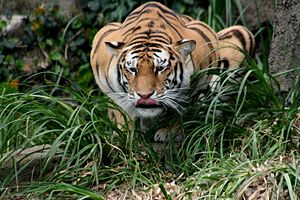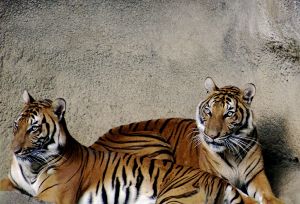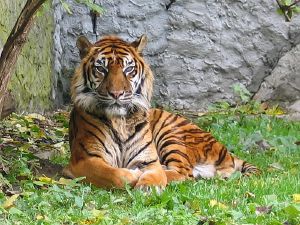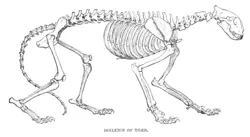Difference between revisions of "Tiger" - New World Encyclopedia
Rick Swarts (talk | contribs) |
Rick Swarts (talk | contribs) |
||
| Line 23: | Line 23: | ||
'''''Tigris regalis''''' <small>[[John Edward Gray|Gray]], 1867</center> | '''''Tigris regalis''''' <small>[[John Edward Gray|Gray]], 1867</center> | ||
| range_map = Tiger_map.jpg | | range_map = Tiger_map.jpg | ||
| − | | range_map_caption= Historical distribution of tigers (pale yellow) and 2006 (green). | + | | range_map_caption= Historical distribution of tigers (pale yellow) and 2006 (green) (NFWF 2007). |
}} | }} | ||
The '''tiger''' (''Panthera tigris'') is a [[mammal]] of the [[Felidae]] family and one of the four species of "big cats" (subfamily Pantherinae) in the ''[[Panthera]]'' [[genus]], along with the [[lion]], (''Panthera leo''), [[jaguar]] (''Panthera onca''), and [[leopard]] (''Panthera pardus''). | The '''tiger''' (''Panthera tigris'') is a [[mammal]] of the [[Felidae]] family and one of the four species of "big cats" (subfamily Pantherinae) in the ''[[Panthera]]'' [[genus]], along with the [[lion]], (''Panthera leo''), [[jaguar]] (''Panthera onca''), and [[leopard]] (''Panthera pardus''). | ||
| Line 123: | Line 123: | ||
== Evolution == | == Evolution == | ||
| − | The | + | The tiger is uncommon in the [[fossil]] record. The oldest remains of a tiger-like cat, called ''[[Panthera palaeosinensis]]'', have been found in China and Java. This species occurred about 2 million years ago at the beginning of the [[Pleistocene]] and was smaller than a tiger. Early true tiger fossils stem from Java and are between 1.6 and 1.8 million years old. Distinct fossils from the early and middle Pleistocene were discovered in deposits from China, Sumatra, and Java. For example, a specimen classified as the subspecies '''[[Trinil Tiger|Trinil tiger]]''' (''Panthera tigris trinilensis'') lived about 1.2 million years ago and was found at the locality of [[Trinil]], [[Java (island)|Java]], [[Indonesia]] (the site of the finding of the fossil of the famous [[Java man]] (Van den Hoek Ostende 2006). |
| − | In India | + | |
| + | In India and northern Asia, the tiger appears for the first time in the late Pleistocene. Fossil tigers were also found in eastern [[Beringia]] and [[Sachalin]] island. Tiger fossils of the late Pleistocene have also turned up in [[Japan]]. These fossils indicate that the Japanese tiger was not bigger than the island subspecies of tigers of recent ages. This may be due to the phenomenon in which body size is related to environmental space (see [[island dwarfism]]), or in the case of a large predator like a tiger, availability of prey. | ||
| + | |||
==Tigers in literature, culture, and medicine== | ==Tigers in literature, culture, and medicine== | ||
| Line 133: | Line 135: | ||
''Could frame thy fearful symmetry?...'' | ''Could frame thy fearful symmetry?...'' | ||
| − | <small>William Blake, "[[The Tyger]]," ''Songs of Experience''. | + | <small>William Blake, "[[The Tyger]]," ''Songs of Experience''. Perhaps the most anthologized poem in the English language.</small> |
</div> | </div> | ||
| − | The | + | The tiger has long been a subject of imaginative literature. Both [[Rudyard Kipling]] in ''[[The Jungle Book]]'' and [[William Blake]] in ''[[Songs of Experience]]'' depict the tiger as a menacing and fearful animal. In ''The Jungle Book'', the tiger, [[Shere Khan]], is the wicked mortal enemy of the protagonist, [[Mowgli]]. However, other depictions are more benign: [[Tigger]], the tiger from [[A. A. Milne]]'s [[Winnie the Pooh]] stories, is cuddly and likable. The famous comic strip ''[[Calvin and Hobbes]]'' features Calvin and his stuffed tiger, Hobbes. A tiger also is featured on the cover of the popular cereal "Frosted Flakes" bearing the name "Tony the Tiger." The tiger is also popular for sports teams nicknames and mascots. |
| − | + | The tiger is one of the 12 [[Chinese zodiac]] animals. In various [[Chinese art]]s and martial arts, the tiger is depicted as an equal rival towards the [[Chinese dragon]]. In [[Imperial China]], a tiger often represented the highest army [[general]] (or present day [[defense secretary]]), while the emperor and empress were represented by a [[dragon]] and [[Fenghuang|phoenix]], respectively. | |
| − | |||
| − | |||
| − | |||
| − | |||
| − | |||
| − | |||
| − | |||
| − | The tiger is one of the 12 [[Chinese zodiac]] animals. | ||
The tiger is regarded as the king of the jungle in most parts of [[Asia]], because its forehead has a marking which resembles the Chinese character 王, which means "king." Consequently, many cartoon depictions of tigers in China are drawn with 王 on their forehead. | The tiger is regarded as the king of the jungle in most parts of [[Asia]], because its forehead has a marking which resembles the Chinese character 王, which means "king." Consequently, many cartoon depictions of tigers in China are drawn with 王 on their forehead. | ||
| − | In a poll | + | In a poll organized by [[Animal Planet]] in 2004, more than 50,000 viewers from 73 countries voted to decide their favorite animal (Manchester 2004). The tiger received 10,904 votes, winning the title of the World's Favorite Animal, beating man's best friend, [[dog]], by 17 votes. Third most popular was the [[dolphin]], followed by the [[horse]] and the [[lion]]. |
| − | |||
| − | |||
| − | |||
| − | |||
| − | + | Many nations have the tiger listed as their national animal, including [[Bangladesh]] (Royal bengal tiger), [[China]] (along with Dragon and Panda), [[India]] (Royal bengal tiger), [[Malaysia]], [[Nepal]] (Royal bengal tiger), [[North Korea]] (Siberian tiger), and [[South Korea]] (Siberian tiger). | |
| − | |||
| − | |||
| − | |||
| − | |||
| − | |||
| − | |||
| − | |||
| − | |||
| − | |||
| − | |||
===Traditional Asian medicine=== | ===Traditional Asian medicine=== | ||
| Line 174: | Line 154: | ||
*The bones found in the tip of the tiger's tail are said to ward off evil spirits. | *The bones found in the tip of the tiger's tail are said to ward off evil spirits. | ||
*Crushed tiger bones added to [[wine]] serves as a Taiwanese general tonic. | *Crushed tiger bones added to [[wine]] serves as a Taiwanese general tonic. | ||
| − | *The feet of a tiger, when dipped in [[palm oil]] and hung in front of a door is said to diminish the likelihood of evil spirits from entering. | + | *The feet of a tiger, when dipped in [[palm oil]] and hung in front of a door, is said to diminish the likelihood of evil spirits from entering. |
| − | *Tiger's skin is said to cure a fever caused by ghosts. | + | *Tiger's skin is said to cure a fever caused by ghosts. In order to use it effectively, the user must sit on the tiger's skin, but beware; if too much time is spent on the tiger's skin, legend says the user will become a tiger. |
| − | *Adding honey to the [[ | + | *Adding honey to the [[gallstone]]s and applying the combination to the hands and feet is said to effectively treat [[abscess]]es. |
| − | *Burnt tiger hair can allegedly drive away [[ | + | *Burnt tiger hair can allegedly drive away [[centipede]]s. |
*Mixing the [[brain]] of a tiger with oil and rubbing the mixture on your body is an alleged cure for both laziness and [[acne]]. | *Mixing the [[brain]] of a tiger with oil and rubbing the mixture on your body is an alleged cure for both laziness and [[acne]]. | ||
*Rolling the [[eyeball]]s into pills is an alleged remedy for [[convulsions]]. | *Rolling the [[eyeball]]s into pills is an alleged remedy for [[convulsions]]. | ||
*If whiskers are kept as a charm, legend says one will be protected against bullets and have increased [[courage]]. | *If whiskers are kept as a charm, legend says one will be protected against bullets and have increased [[courage]]. | ||
| − | *One will allegedly possess courage and shall be protected from sudden fright if you wear a tiger's claw as a piece of [[ | + | *One will allegedly possess courage and shall be protected from sudden fright if you wear a tiger's claw as a piece of [[jewelery]] or carry one in your pocket. |
*Strength, cunning, and courage can allegedly be obtained by consuming a tiger's [[heart]]. | *Strength, cunning, and courage can allegedly be obtained by consuming a tiger's [[heart]]. | ||
*Floating ribs of a tiger are considered a good luck [[Amulet|talisman]]. | *Floating ribs of a tiger are considered a good luck [[Amulet|talisman]]. | ||
*The tiger's penis is said to be an aphrodisiac. | *The tiger's penis is said to be an aphrodisiac. | ||
| − | *Small bones in a tiger's feet tied to a child's [[wrists]] are said to be a | + | *Small bones in a tiger's feet tied to a child's [[wrists]] are said to be a cure for convulsions. |
| − | |||
| − | |||
| − | |||
| − | |||
| − | |||
| − | |||
| − | |||
| − | |||
| − | |||
| − | |||
| − | |||
| − | |||
| − | |||
| − | |||
| − | |||
| + | ===Pet tigers=== | ||
| + | The [[American Zoo and Aquarium Association]] estimates that up to 12,000 tigers are being kept as private pets in the USA, which is significantly more than the world's entire wild population (Lloyd and Mitchinson 2006). Part of the reason for the enormous privately held tiger population in the United States relates to legislation. Only nineteen states have banned private ownership of tigers, fifteen require only a licence, and sixteen states have no regulations at all (Lloyd and Mitchinson 2006). | ||
| + | The success of breeding programmes at American zoos and circuses led to an overabundance of cubs in the 1980's and 90's, which drove down prices for the animals. The Society for the Prevention of Cruelty to Animals (SPCA) estimates there are now 500 lions, tigers and other big cats in private ownership just in the Houston area (Lloyd and Mitchinson 2006). | ||
==Media== | ==Media== | ||
| Line 214: | Line 182: | ||
{{multi-video item|filename=Panthera tigris6.ogg|title=Panthera tigris #6|description= |format=[[Theora]]}} | {{multi-video item|filename=Panthera tigris6.ogg|title=Panthera tigris #6|description= |format=[[Theora]]}} | ||
{{multi-video item|filename=Panthera tigris7.ogg|title=Panthera tigris #7|description= |format=[[Theora]]}} | {{multi-video item|filename=Panthera tigris7.ogg|title=Panthera tigris #7|description= |format=[[Theora]]}} | ||
| − | |||
{{multi-video end}} | {{multi-video end}} | ||
| Line 220: | Line 187: | ||
* [http://endangeredtv.com/video_player.cfm?animalid=74 Endangered TV] Video of the Sumatran Tiger and other Endangered Animals. | * [http://endangeredtv.com/video_player.cfm?animalid=74 Endangered TV] Video of the Sumatran Tiger and other Endangered Animals. | ||
* [http://endangeredtv.com/video_player.cfm?animalid=76 Endangered TV] Video of the Indochinese Tiger and other Endangered Animals. | * [http://endangeredtv.com/video_player.cfm?animalid=76 Endangered TV] Video of the Indochinese Tiger and other Endangered Animals. | ||
| − | |||
| − | |||
| − | |||
| − | == | + | == Gallery== |
| − | + | <gallery> | |
| − | + | Image:Brehms Het Leven der Dieren Zoogdieren Orde 4 Tijger (Felis tigris).jpg|Picture of Felis tigris (Panthera tigris) subspecies unknown | |
| − | + | Image:Indischer Maler um 1650 (II) 001.jpg|Indian painting, ca. 1650|Indian painting | |
| − | + | Image:Nazitiger1.jpg|Soviet propaganda against the "Nazi Tiger." | |
| − | + | Image:Coat of arms of Malaysia.png|Coat of Arms of Malaysia. | |
| − | + | Image:Coat of arms of Tamil Eelam.png|Coat of Arms of Tamil Eelam | |
| − | + | </gallery> | |
| − | |||
| − | |||
| − | |||
==Notes== | ==Notes== | ||
| Line 265: | Line 226: | ||
<ref>Sunquist, Mel and Fiona Sunquist. 2002. Wild Cats of the World. University Of Chicago Press, Chicago</ref>. | <ref>Sunquist, Mel and Fiona Sunquist. 2002. Wild Cats of the World. University Of Chicago Press, Chicago</ref>. | ||
| − | + | Manchester. 2004. <ref>{{Cite news | url = http://www.manchestereveningnews.co.uk/news/s/139/139264_tiger_is_worlds_favourite_animal.html | title = Title is world's favourite animal | date = 2004-06-12 | accessdate = 2007-07-11 | work = [[Manchester Evening News]]}}</ref> | |
<ref>* Vratislav Mazak: ''Der Tiger''. Nachdruck der 3. Auflage von 1983. Westarp Wissenschaften Hohenwarsleben, 2004 ISBN 3 894327596</ref>. | <ref>* Vratislav Mazak: ''Der Tiger''. Nachdruck der 3. Auflage von 1983. Westarp Wissenschaften Hohenwarsleben, 2004 ISBN 3 894327596</ref>. | ||
| Line 273: | Line 234: | ||
<ref>Cracraft J., Felsenstein J., Vaughn J., Helm-Bychowski K. (1998) Sorting out tigers (Panthera tigris) Mitochondrial sequences, nuclear inserts, systematics, and conservation genetics. Animal Conservation 1: 139–150.</ref> | <ref>Cracraft J., Felsenstein J., Vaughn J., Helm-Bychowski K. (1998) Sorting out tigers (Panthera tigris) Mitochondrial sequences, nuclear inserts, systematics, and conservation genetics. Animal Conservation 1: 139–150.</ref> | ||
<ref>Sunquist, Fiona & Mel Sunquist. 1988. Tiger Moon. The University of Chicago Press, Chicago.</ref> | <ref>Sunquist, Fiona & Mel Sunquist. 1988. Tiger Moon. The University of Chicago Press, Chicago.</ref> | ||
| + | |||
| + | Naitonal Fish and Wildlife Foundation. 2007. <ref>http://www.savethetigerfund.org</ref> | ||
| + | |||
<ref>Sunquist, Mel and Fiona Sunquist. 2002. Wild Cats of the World. University Of Chicago Press, Chicago</ref> | <ref>Sunquist, Mel and Fiona Sunquist. 2002. Wild Cats of the World. University Of Chicago Press, Chicago</ref> | ||
<ref>Indian Jungles (IJ). 2005. [http://www.indianjungles.com/090805d.htm Task force says tigers under siege]</ref> | <ref>Indian Jungles (IJ). 2005. [http://www.indianjungles.com/090805d.htm Task force says tigers under siege]</ref> | ||
| + | |||
| + | <ref>Van den Hoek Ostende, L. W. 2006. Javan Tiger - Ruthlessly hunted down. [http://www.naturalis.nl/300pearls 300 Pearls - Museum highlights of natural diversity]. Downloaded on 11 August 2006.</ref> | ||
| + | |||
| + | |||
| + | <ref>[[John Lloyd (writer)|Lloyd, J]] & [[John Mitchinson|Mitchinson, J]]: "[[The Book of General Ignorance]]." Faber & Faber, 2006.</ref> 4000 are believed to be in captivity in Texas alone. <ref>[[John Lloyd (writer)|Lloyd, J]] & [[John Mitchinson|Mitchinson, J]]: "[[The Book of General Ignorance]]." Faber & Faber, 2006.</ref> | ||
| + | |||
;General references | ;General references | ||
| Line 285: | Line 255: | ||
==External links== | ==External links== | ||
| − | |||
| − | |||
| − | |||
| − | |||
| − | |||
| − | |||
| − | |||
| − | |||
| − | |||
| − | |||
| − | + | *[http://www.discoverwild.org/vthapar.html Can India's tigers survive extinction?] Author Valmik Thapar on the tiger crisis. Retrieved August 1, 2007. | |
| − | + | *[http://imagineanimals.com/endangered/indochinese_tiger/index.htm Imagine Animals] Free images of the Indochinese Tiger and other Endangered Animals. Retrieved August 1, 2007. | |
| − | + | *[http://imagineanimals.com/endangered/siberian_tiger/index.htm Imagine Animals] Free images of the Siberian Tiger and other Endangered Animals. Retrieved August 1, 2007. | |
| − | + | *[http://imagineanimals.com/endangered/sumatran_tiger/index.htm Imagine Animals] Free images of the Sumatran Tiger and other Endangered Animals. Retrieved August 1, 2007. | |
| − | + | ||
| − | |||
| − | |||
| − | |||
| − | |||
| − | |||
| − | |||
| − | |||
| − | |||
| − | |||
| − | |||
| − | |||
| − | |||
| − | |||
| − | |||
| − | |||
| − | |||
[[Category:Life sciences]] | [[Category:Life sciences]] | ||
{{credit|145910319}} | {{credit|145910319}} | ||
Revision as of 21:58, 1 August 2007
| Tiger | ||||||||||||||
|---|---|---|---|---|---|---|---|---|---|---|---|---|---|---|
 Bengal Tiger (P. tigris tigris)
| ||||||||||||||
| Scientific classification | ||||||||||||||
| ||||||||||||||
| Panthera tigris (Linnaeus, 1758) | ||||||||||||||
 Historical distribution of tigers (pale yellow) and 2006 (green) (NFWF 2007).
| ||||||||||||||
|
Tigris striatus Severtzov, 1858 |
The tiger (Panthera tigris) is a mammal of the Felidae family and one of the four species of "big cats" (subfamily Pantherinae) in the Panthera genus, along with the lion, (Panthera leo), jaguar (Panthera onca), and leopard (Panthera pardus).
Native to the mainland of southeastern Asia, the tiger is an apex predator and the largest surviving feline species in the world. The critical endangered Siberian tiger, confined to small parts of Russia, China, and Korea, is the largest subspecies of tiger. The Bengal tiger is the most common subspecies of tiger, constituting approximately 80% of the entire tiger population, and is found in India, Bangladesh, Bhutan, Myanmar, and Nepal.
The tiger is solitary and territorial, preferring cover in deep forest, but also ranging in open areas. The cat hunts by stalk-and-ambush and may take a variety of mid- and large-sized prey, particularly ungulates. Males are much larger than females and have larger home ranges.
An endangered species, it is estimated that the majority of the world's tigers now live in captivity (VS 2006). There are nine recognized extant tiger subspecies.
Physical characteristics
Tigers are the heaviest species of cat found in the wild. The liger is actually the largest cat in the world, but it is not a species or subspecies but a non-breeding hybrid, being a cross between a male Panthera leo (lion), and a female Panthera tigris (tiger); it is denoted scientifically as Panthera tigris × Panthera leo (Milne 1927). The larger tigers are comparable in size to the biggest fossil felids.
The tiger subspecies differ strongly in size. Large male Siberian tigers (Panthera tigris altaica) can reach a total length of 3.5 meters (m) and a weight of 300 kilograms (kg). Apart of those exceptional large individuals, male Siberian tigers usually have a head and body length of 190-220 centimeters (cm) and an average weight of 250 kg. (The tail of a tiger is 60-110 cm long.) The heaviest Indian Tiger (P. t. tigris) that is confirmed through reliable sources weighed 258 kg (570 pounds). Reports of tigers weighing far more than 300 kg are mentioned in literature, but none of these cases is confirmed (Mazak 1983). Females are smaller, those of the Siberian or Indian subspecies weigh only between 100 and 167 kg. Isle tigers like the Sumatran subspecies (P. t. sumatrae) are much smaller than mainland tigers and weigh usually only 100-140 kg in males and 75-110 kg in females. The extinct Bali tiger (P. t. balica) was even smaller with a weight of 90-100 kg in males and 65-80 kg in females.
Tigers have rusty-reddish to yellow-rusty coats, a whitish medial and ventral area, and stripes that vary from brown or hay to pure black. The form and density of stripes differs between subspecies, but most tigers have in excess of 100 stripes. The pattern of stripes is unique to each animal, and thus could potentially be used to identify individuals, much in the same way as fingerprints are used to identify people. This is not, however, a preferred method of identification, due to the difficulty of recording the stripe pattern of a wild tiger. It seems likely that the function of stripes is camouflage, serving to hide these animals from their prey. The stripe pattern is found on a tiger's skin, and if shaved, its distinctive camouflage pattern would be preserved.
There is a well-known mutation that produces the white tiger, an animal that is rare in the wild, but widely bred in zoos due to its popularity. The white tiger is not a separate sub-species, but only a color variation. There are also unconfirmed reports of a "blue" or slate-colored tiger, and largely or totally black tigers, and these are assumed, if real, to be intermittent mutations rather than distinct species.
Like most cats, tigers are believed to have some degree of color vision (SWBG 2002). Similar to the lion, the tiger has the ability to roar.
Biology and ecology
Habitat
Tigers are found in a variety of habitats, from tropical rainforests and boreal forests to dry savannas, as they are found in Ranthambore National Park. Compared to the lion, the tiger prefers more dense vegetation, for which its camouflage is ideally suited, and where a single predator is not at a disadvantage compared to a pride. Among the big cats, only the tiger and jaguar are strong swimmers; tigers are often found bathing in ponds, lakes, and rivers.
Home Range
Adult tigers are territorial and fiercely defensive. The size of a tiger's home range mainly depends on prey abundance and, in case of male tigers, access to females. A tigress may have a territory of 20 km², while the territories of males are much larger, covering 60-100 km². Female territories may overlap those of many females, but males are usually intolerant of other males within their territory. Because of their aggressive nature, territorial disputes can be violent and may end in the death of one of the males, though deaths are uncommon. Most encounters between tigers end without physical incident.
To identify his territory, the male marks trees by spraying urine and anal gland secretions on trees as well as by marking trails with scat. Males show a behavior called flehmen, a grimacing face, when identifying a female's reproductive condition by sniffing their urine markings.
Tigers have been studied in the wild using a variety of techniques. The populations of tigers were estimated in the past using plaster casts of their pugmarks (footprints). In recent times, camera trapping has been used instead. Newer techniques based on DNA from their scat are also being evaluated. Radio collaring has been a popular approach to tracking them for study in the wild.
Reproduction and life cycle
A female is only receptive for a few days and mating is frequent during that time period. A pair will copulate frequently and noisily, like other cats. The gestation period is 103 days and 3–4 cubs of about 1 kg (2 lb) each are born. The females rear them alone. Wandering male tigers may kill cubs to make the female receptive.
At 8 weeks, the cubs are ready to follow their mother out of the den. The cubs become independent around 18 months of age, but it is not until they are around 2–2½ years old that they leave their mother. The cubs reach sexual maturity by 3–4 years of age. The female tigers generally own territory near their mother, while males tend to wander in search of territory, which they acquire by fighting and eliminating another male.
Over the course of her life, a female tiger will give birth to an approximately equal number of male and female cubs. Tigers breed well in captivity, and the captive population in the United States may rival the wild population of the world.
Food
In the wild, tigers mostly feed on larger ungulates (hoofed mammals), but they also take smaller prey. Tigers have been known to kill crocodiles on occasion (Bangalinet 2007; Sunquist and Sunquist 1988), although predation is rare and the predators typically avoid one another. Siberian tigers and brown bears are a serious threat to each other and both tend to avoid each other; however, tigers can and do kill larger brown bears. Even female tigers, which are considerably smaller than male tigers, are capable of taking down and killing adult gaurs by themselves. Sambar deer, wild boar, and gaur are the tiger's favored prey in India.
Like many predators, tigers are opportunistic and have shown the capability to eat much smaller prey such as as langurs, peacocks, and hares. They also may kill such formidable predators as sloth bear, canids, leopards, and pythons as prey. Old and injured tigers have been known to attack humans or domestic cattle and are then termed as man-eaters or cattle-lifters, which often leads to them being captured, shot or poisoned. The Sundarbans mangrove swamps of Bengal, where some healthy tigers have been known to hunt humans, have had a higher incidence of man-eaters.
In all of their range, tigers are the top predators and do not compete with other carnivores other than the dhole or Indian wild dog, which makes up for its relative lack of strength by numbers. While swimming, crocodiles can be dangerous to a tiger (Bangalinet 2007). Adult elephants are too dangerous to tigers to serve as common prey, but conflicts between elephants and tigers do sometimes take place. Young elephant and rhino calves are occasionally taken when they are left unprotected by their herds. A case where a tiger killed an adult female Indian rhino has been observed (Haemig 2007)
However, a desperate tiger will attack anything it regards as potential food, including humans.
Hunting methods
Tigers primarily sleep during the day and begin hunting at dusk (Banglanet 2007). Tigers hunt alone and prefer primarily medium to large sized herbivores. They ambush their prey as other cats do, overpowering their prey from any angle, using their body size and strength to knock prey off balance. Even with their great masses, tigers can reach speeds of about 60 km/h (37 mph). The tiger uses its muscled forelimbs to hold onto the prey, bringing it to the ground. Once the prey is prone, the tiger bites the back of the neck, often breaking the prey's spinal cord, piercing the windpipe, or severing the jugular vein or carotid artery. Tigers prefer to bite the throats of large prey. The tiger remains latched onto the neck until its prey dies.
In the wild, tigers can leap as high as 5 m (16 ft) and as far as 9-10 m (30-33 ft), making them one of the highest-jumping mammals (just slightly behind cougars in jumping ability).
They have been reported to carry domestic livestock weighing 50 kg (110 lb) while easily jumping over fences 2 m (6 ft 6 in) high. Their heavily muscled forelimbs are used to hold tightly onto the prey and to avoid being dislodged, especially by large prey such as gaurs. Gaurs and water buffalo weighing over a ton have been killed by tigers weighing about a sixth as much. A single blow from a tiger's paw can kill a full-grown dog or human, or can incapacitate a 150 kg (330 lb) Sambar deer.
Extinction risk
Humans are the tiger's most significant predator, as tigers are often poached illegally for their fur. Such poaching, as well as destruction of habitat, has greatly reduced tiger populations in the wild. A century ago, it is estimated there were over 100,000 tigers in the world; now numbers are down to below 2,500 mature breeding individuals, with no subpopulation containing more than 250 mature breeding individuals [1]. The threat of extinction is mitigated, however, by the presence of some 20,000 tigers currently in captivity.
Many Indian tigers' parts find their way to China through Tibet, where it is widely used for making traditional costumes. At the Kalachakra Tibetan Buddhist festival in south India in January 2006, one of the most important Tibetian Buddhist festivals, the Dalai Lama preached a ruling against using, selling, or buying wild animals, their products, or derivatives (Denyer 2006; Huggler 2006). Subsequently, when Tibetan pilgrims returned to Tibet afterwards, there was much destruction by Tibetans of their wild animal skins, including tiger and leopard skins used as ornamental garments and valued at many thousands of dollars (Denyer 2006; Huggler 2006). It has yet to be seen whether this will result in a long-term slump in the demand for poached tiger and leopard skins.
Tiger bones and nearly all body parts are used in traditional Chinese medicine for a range of purported uses including pain killers and aphrodisiacs. The use of tiger parts in pharmaceutical drugs in China is already banned. China has even made some offenses in connection with Tiger poaching punishable by death.
Subspecies
There are nine recent subspecies of tiger, three of which are extinct and one of which is almost certain to become extinct in the near future. The historical range of tigers (severely diminished today) ran through Russia, Siberia, Iran, Afghanistan, India, China, and south-east Asia, including the Indonesian islands.
These are the surviving subspecies, in descending order of wild population:
- The Bengal tiger or the Royal Bengal tiger (Panthera tigris tigris) is found in parts of India, Bangladesh, Nepal, Bhutan, and Myanmar. It lives in varied habitats—grasslands, subtropical and tropical rainforests, scrub forests, wet and dry deciduous forests and mangroves. Male Bengal tigers range anywhere from 180 to 258 kg and females range between 100-160 kg. Males in the wild usually weigh 205 to 227 kg (450-500 lb), while the average female will weigh about 130 kg (Sunquist and Sunquist 2002). However, the northern Indian and the Nepalese Bengal tigers are considerably bulkier than those found in the south of the Indian Subcontinent. The Indian government's estimated population figure for these tigers is between 3,100 and 4,500, some 3,000 of which are found in India alone. However, many Indian tiger conservationists doubt this number, seeing it as overly optimistic. The number of Bengal tigers in India may be fewer than 2,000 (IJ 2005), as most of the collected statistics are based on pugmark (footprint) identification, which often gives a biased result. Even though this is the most "common" tiger, these tigers are under severe pressure from both habitat destruction and poaching. In 1972, India launched a massive wildlife conservation project, known as Project Tiger, to protect the depleting numbers of tigers in India. The project helped increase the population of these tigers from 1,200 in the 1970s to 3,000 in the 1990s and is considered as one of the most successful wildlife conservation programs.
- The Indochinese tiger (Panthera tigris corbetti), also called Corbett's tiger, is found in Cambodia, China, Laos, Myanmar, Thailand, and Vietnam. Indochinese tigers are smaller and darker than Bengal tigers. Males weigh from 150-190 kg (330-420 lb) on average, while females are smaller at 110-140 kg (242-308 lb). Estimates of its population vary between 1,200 to 1,800, but it seems likely that the number is in the lower part of the range. The largest current population is in Malaysia, where illegal poaching is strictly controlled, but all existing populations are at extreme risk from habitat fragmentation and inbreeding. In Vietnam, almost three-quarters of the tigers killed provide stock for Chinese pharmacies. Also, the tigers are seen by poor natives as a resource through which they can ease poverty.
- The Malayan tiger (Panthera tigris jacksoni), exclusively found in the southern (Malaysian) part of the Malay Peninsula, was not considered a subspecies in its own right until 2004. The new classification came about after a study by Luo et al. from the Laboratory of Genomic Diversity Study, part of the National Cancer Institute of the United States. Recent counts showed there are 600-800 tigers in the wild, making it the third largest tiger population behind the Bengal tiger and the Indochinese tiger. The Malayan tiger is a national icon in Malaysia, appearing on its coat of arms and in logos of Malaysian institutions, such as Maybank.
- The Sumatran tiger (Panthera tigris sumatrae) is found only on the Indonesian island of Sumatra. The Sumatran tiger is the smallest of all living tiger subspecies. Adult males weigh between 100-130 kg (220-286 lb), females 70-90 kg (154-198 lb). Their small size is a useful adaptation to the thick, dense forests of the Sumatra island where they reside, as well as the smaller-sized prey. The wild population is estimated at between 400 and 500, seen chiefly in the island's national parks. Recent genetic testing has revealed the presence of unique genetic markers, which have led some to speculate that it has the potential to diverge into a separate species, if it is not made extinct (Cracraft et al. 1998). Habitat destruction is the main threat to the existing tiger population (logging continues even in the supposedly protected national parks), but 66 tigers were recorded as being shot and killed between 1998 and 2000, or nearly 20% of the total population.
- The Amur tiger (Panthera tigris altaica), also known as the Siberian, Manchurian, or North China tiger, is confined completely to the Amur region in far eastern Siberia, where it is now protected. It is considered the largest subspecies of tiger (although the limited populations of northern Indian and Nepalese Bengal tigers possibly are larger in comparison.) The largest Amur (Siberian) tiger on record weighed 306 kg (675 lb) (Mazak 1983). The average weight of a male Amur tiger is around 227 kg (500 lb) (Sunquist and Sunquist 2002). The Amur tiger is also noted for its thick coat, distinguished by a paler golden hue and a smaller number of stripes. The Amur tiger is the largest and heaviest of all living felines. A six-month old Amur tiger can be as big as a fully grown leopard. There is only one cat that grows to a larger size than the male Siberian Tiger: the Liger, a hybrid, whose parents are always a male lion and a female tiger. The last two censuses (1996 and 2005) found 450-500 Amur tigers within their single and more or less continuous range, making it one of the largest undivided tiger populations in the world.
- The South China tiger (Panthera tigris amoyensis), also known as the Amoy or Xiamen tiger, is the most critically endangered subspecies of tiger and it is largely expected that it will become extinct. It is one of the smaller tiger subspecies. The length of the South China tiger ranges from 2.2-2.6 m (87-104 in) for both males and females. Males weigh between 127 and 177 kg (280-390 lb) while females weigh between 100 and 118 kg (220-260 lb). It seems likely that the last known wild South China tiger was shot and killed in 1994, and no live tigers have been seen in their natural habitat for the last 20 years. In 1977, the Chinese government passed a law banning the killing of wild tigers, but this appears to have been too late to save the subspecies. There are currently 59 known captive South China tigers, all within China, but these are known to be descended from only six animals. Thus, the genetic diversity required to maintain the subspecies may no longer exist, making extinction a possibility. Currently, there are breeding efforts to reintroduce these tigers to the wild by 2008.
Extinct tiger subspecies
- The Balinese tiger (Panthera tigris balica) has always been limited to the island of Bali. These tigers were hunted to extinction—the last Balinese tiger is thought to have been killed at Sumbar Kima, West Bali on September 27, 1937; this was an adult female. No Balinese tiger was ever held in captivity. The tiger still plays an important role in Balinese Hindu religion.
- The Javan tiger (Panthera tigris sondaica) was limited to the Indonesian island of Java. It now seems likely that this subspecies was made extinct in the 1980s, as a result of hunting and habitat destruction, but the extinction of this subspecies was extremely probable from the 1950s onwards (when it is thought that fewer than 25 tigers remained in the wild). The last specimen was sighted in 1979.
- The Caspian tiger or Persian Tiger (Panthera tigris virgata) appears to have become extinct in the late 1960s, with the last reliable sighting in 1968, though it is thought that such a tiger was last shot dead in the south-eastern-most part of Turkey in 1970. Historically it ranged through Afghanistan, Iran, Iraq, Pakistan, the former Soviet Union, and Turkey. The Caspian tiger was a large subspecies and reached nearly the dimensions of the Bengal Tiger. The heaviest confirmed weight of a male was 240kg. The ground color was comparable to that of the indian subspecies, but differed especially in the tight, narrow striping pattern. The stripes were rather dark gray or brown than black. Especially during the winter the fur was relatively long. The Caspian tiger was one of two subspecies of tiger (along with the Bengal) that was used by the Romans to battle gladiators and other animals, including the Barbary Lion.
Evolution
The tiger is uncommon in the fossil record. The oldest remains of a tiger-like cat, called Panthera palaeosinensis, have been found in China and Java. This species occurred about 2 million years ago at the beginning of the Pleistocene and was smaller than a tiger. Early true tiger fossils stem from Java and are between 1.6 and 1.8 million years old. Distinct fossils from the early and middle Pleistocene were discovered in deposits from China, Sumatra, and Java. For example, a specimen classified as the subspecies Trinil tiger (Panthera tigris trinilensis) lived about 1.2 million years ago and was found at the locality of Trinil, Java, Indonesia (the site of the finding of the fossil of the famous Java man (Van den Hoek Ostende 2006).
In India and northern Asia, the tiger appears for the first time in the late Pleistocene. Fossil tigers were also found in eastern Beringia and Sachalin island. Tiger fossils of the late Pleistocene have also turned up in Japan. These fossils indicate that the Japanese tiger was not bigger than the island subspecies of tigers of recent ages. This may be due to the phenomenon in which body size is related to environmental space (see island dwarfism), or in the case of a large predator like a tiger, availability of prey.
Tigers in literature, culture, and medicine
Tyger! Tyger! Burning bright
In the forests of the night,
What immortal hand or eye
Could frame thy fearful symmetry?...
William Blake, "The Tyger," Songs of Experience. Perhaps the most anthologized poem in the English language.
The tiger has long been a subject of imaginative literature. Both Rudyard Kipling in The Jungle Book and William Blake in Songs of Experience depict the tiger as a menacing and fearful animal. In The Jungle Book, the tiger, Shere Khan, is the wicked mortal enemy of the protagonist, Mowgli. However, other depictions are more benign: Tigger, the tiger from A. A. Milne's Winnie the Pooh stories, is cuddly and likable. The famous comic strip Calvin and Hobbes features Calvin and his stuffed tiger, Hobbes. A tiger also is featured on the cover of the popular cereal "Frosted Flakes" bearing the name "Tony the Tiger." The tiger is also popular for sports teams nicknames and mascots.
The tiger is one of the 12 Chinese zodiac animals. In various Chinese arts and martial arts, the tiger is depicted as an equal rival towards the Chinese dragon. In Imperial China, a tiger often represented the highest army general (or present day defense secretary), while the emperor and empress were represented by a dragon and phoenix, respectively.
The tiger is regarded as the king of the jungle in most parts of Asia, because its forehead has a marking which resembles the Chinese character 王, which means "king." Consequently, many cartoon depictions of tigers in China are drawn with 王 on their forehead.
In a poll organized by Animal Planet in 2004, more than 50,000 viewers from 73 countries voted to decide their favorite animal (Manchester 2004). The tiger received 10,904 votes, winning the title of the World's Favorite Animal, beating man's best friend, dog, by 17 votes. Third most popular was the dolphin, followed by the horse and the lion.
Many nations have the tiger listed as their national animal, including Bangladesh (Royal bengal tiger), China (along with Dragon and Panda), India (Royal bengal tiger), Malaysia, Nepal (Royal bengal tiger), North Korea (Siberian tiger), and South Korea (Siberian tiger).
Traditional Asian medicine
Tiger parts are used in traditional Chinese medicines. Many people in China believe that tiger parts have medicinal properties. There is no scientific corroboration to these beliefs, which include:
- The tail of the tiger is sometimes ground and mixed with soap to create an ointment for use in treating skin cancer.
- The bones found in the tip of the tiger's tail are said to ward off evil spirits.
- Crushed tiger bones added to wine serves as a Taiwanese general tonic.
- The feet of a tiger, when dipped in palm oil and hung in front of a door, is said to diminish the likelihood of evil spirits from entering.
- Tiger's skin is said to cure a fever caused by ghosts. In order to use it effectively, the user must sit on the tiger's skin, but beware; if too much time is spent on the tiger's skin, legend says the user will become a tiger.
- Adding honey to the gallstones and applying the combination to the hands and feet is said to effectively treat abscesses.
- Burnt tiger hair can allegedly drive away centipedes.
- Mixing the brain of a tiger with oil and rubbing the mixture on your body is an alleged cure for both laziness and acne.
- Rolling the eyeballs into pills is an alleged remedy for convulsions.
- If whiskers are kept as a charm, legend says one will be protected against bullets and have increased courage.
- One will allegedly possess courage and shall be protected from sudden fright if you wear a tiger's claw as a piece of jewelery or carry one in your pocket.
- Strength, cunning, and courage can allegedly be obtained by consuming a tiger's heart.
- Floating ribs of a tiger are considered a good luck talisman.
- The tiger's penis is said to be an aphrodisiac.
- Small bones in a tiger's feet tied to a child's wrists are said to be a cure for convulsions.
Pet tigers
The American Zoo and Aquarium Association estimates that up to 12,000 tigers are being kept as private pets in the USA, which is significantly more than the world's entire wild population (Lloyd and Mitchinson 2006). Part of the reason for the enormous privately held tiger population in the United States relates to legislation. Only nineteen states have banned private ownership of tigers, fifteen require only a licence, and sixteen states have no regulations at all (Lloyd and Mitchinson 2006).
The success of breeding programmes at American zoos and circuses led to an overabundance of cubs in the 1980's and 90's, which drove down prices for the animals. The Society for the Prevention of Cruelty to Animals (SPCA) estimates there are now 500 lions, tigers and other big cats in private ownership just in the Houston area (Lloyd and Mitchinson 2006).
Media
Video of the Panthera tigris at Disney's Animal Kingdom
|
|
- Endangered TV Video of the Siberian Tiger and other Endangered Animals.
- Endangered TV Video of the Sumatran Tiger and other Endangered Animals.
- Endangered TV Video of the Indochinese Tiger and other Endangered Animals.
Gallery
- Nazitiger1.jpg
Soviet propaganda against the "Nazi Tiger."
- Coat of arms of Malaysia.png
Coat of Arms of Malaysia.
- Coat of arms of Tamil Eelam.png
Coat of Arms of Tamil Eelam
Notes
- ↑ 1.0 1.1 Cat Specialist Group 2002. Panthera tigris. 2006 IUCN Red List of Threatened Species., World Conservation Union. Retrieved on May 10, 2006. Database entry includes justification for why this species is endangered.
ReferencesISBN links support NWE through referral fees
• Vital Statistics. 2006. http://www.vitalstatistics.info/sub-category2.asp?cid=6&scid=1349 Animals: Tigers.
. [2] Haemig PD (2007) Sympatric Tiger and Leopard. ECOLOGY.INFO 22
[1] Independent Online. Dalai Lama offers Indian tigers a lifeline
March 06 2006 at 01:58PM
By Simon Denyer
[2]
Fur flies over tiger plight By Justin Huggler New Zealand Herald 18 February 2006
[3].
[4].
Manchester. 2004. [5]
[6].
Naitonal Fish and Wildlife Foundation. 2007. [10]
[14] 4000 are believed to be in captivity in Texas alone. [15]
- General references
- Mazák, V. 1981. Panthera tigris. Mammalian Species, 152: 1-8. American Society of Mammalogists. (Available online)
- Ronald M. Nowak: Walker's Mammals of the World. Johns Hopkins University Press, 1999 ISBN 0-8018-5789-9
- Tom Brakefield. 1993. Big cats kingdom of might, Voyageur press.
- John Seidensticker: Riding the Tiger. Tiger Conservation in Human-dominated Landscapes Cambridge University Press, 1999 ISBN 0521648351
External links
- Can India's tigers survive extinction? Author Valmik Thapar on the tiger crisis. Retrieved August 1, 2007.
- Imagine Animals Free images of the Indochinese Tiger and other Endangered Animals. Retrieved August 1, 2007.
- Imagine Animals Free images of the Siberian Tiger and other Endangered Animals. Retrieved August 1, 2007.
- Imagine Animals Free images of the Sumatran Tiger and other Endangered Animals. Retrieved August 1, 2007.
Credits
New World Encyclopedia writers and editors rewrote and completed the Wikipedia article in accordance with New World Encyclopedia standards. This article abides by terms of the Creative Commons CC-by-sa 3.0 License (CC-by-sa), which may be used and disseminated with proper attribution. Credit is due under the terms of this license that can reference both the New World Encyclopedia contributors and the selfless volunteer contributors of the Wikimedia Foundation. To cite this article click here for a list of acceptable citing formats.The history of earlier contributions by wikipedians is accessible to researchers here:
The history of this article since it was imported to New World Encyclopedia:
Note: Some restrictions may apply to use of individual images which are separately licensed.
- ↑ Sea World/Busch Gardens (SWBG). 2002. Senses part from Busch Gardens Animal Information Database - Tiger infobook.
- ↑ http://www.ecology.info/tiger-leopard.htm
- ↑ * Vratislav Mazak: Der Tiger. Nachdruck der 3. Auflage von 1983. Westarp Wissenschaften Hohenwarsleben, 2004 ISBN 3 894327596
- ↑ Sunquist, Mel and Fiona Sunquist. 2002. Wild Cats of the World. University Of Chicago Press, Chicago
- ↑ "Title is world's favourite animal", Manchester Evening News, 2004-06-12. Retrieved 2007-07-11.
- ↑ * Vratislav Mazak: Der Tiger. Nachdruck der 3. Auflage von 1983. Westarp Wissenschaften Hohenwarsleben, 2004 ISBN 3 894327596
- ↑ Bangalinet. 2007. http://www.bangalinet.com/tiger1.htm Tiger.
- ↑ Cracraft J., Felsenstein J., Vaughn J., Helm-Bychowski K. (1998) Sorting out tigers (Panthera tigris) Mitochondrial sequences, nuclear inserts, systematics, and conservation genetics. Animal Conservation 1: 139–150.
- ↑ Sunquist, Fiona & Mel Sunquist. 1988. Tiger Moon. The University of Chicago Press, Chicago.
- ↑ http://www.savethetigerfund.org
- ↑ Sunquist, Mel and Fiona Sunquist. 2002. Wild Cats of the World. University Of Chicago Press, Chicago
- ↑ Indian Jungles (IJ). 2005. Task force says tigers under siege
- ↑ Van den Hoek Ostende, L. W. 2006. Javan Tiger - Ruthlessly hunted down. 300 Pearls - Museum highlights of natural diversity. Downloaded on 11 August 2006.
- ↑ Lloyd, J & Mitchinson, J: "The Book of General Ignorance." Faber & Faber, 2006.
- ↑ Lloyd, J & Mitchinson, J: "The Book of General Ignorance." Faber & Faber, 2006.











